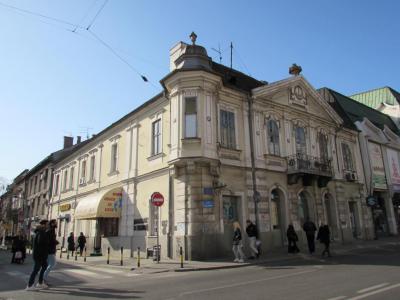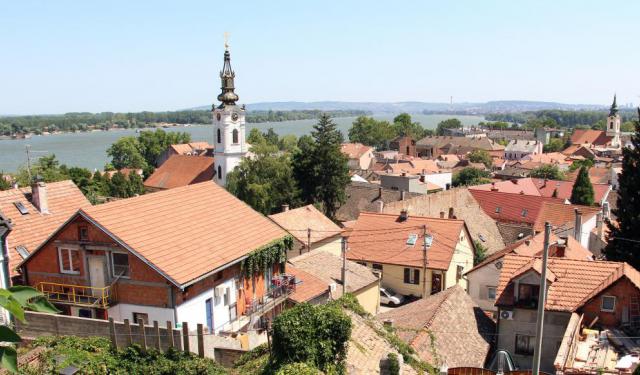
House with the Sundial, Belgrade
The House with the Sundial is a notable landmark in the central area of Zemun, Belgrade. This 19th-century corner mansion, located at the intersection of Glavna Street and Dubrovacka Street, stands out for its functioning sun clock on the side facing Dubrovacka Street. Constructed in 1823 and adorned with the sundial in 1828, the building is an exquisite blend of Classical style with Baroque elements, incorporating Greco-Roman, Egyptian, and Renaissance art influences. The mansion is built from brick and features a bell cupola and decorative plaster embellishments on its main facade.
The distinctive sundial displays the daytime hours from 8 AM to 3 PM in solar time, showcasing a unique arrangement of figures significant in Serbian astronomical history. The mansion also bears a crest with an anchor, symbolizing its founder’s involvement in maritime trade.
Originally designed as a residential commercial property, the house includes a basement, ground floor, and first floor. The ground floor likely served as a space for bars and shops, while the upper floor remains residential. Despite extensions and damage during World War II, the sundial has remained intact.
Prominent Serbian writer Jovan Subotić spent his final years in this house, contributing to its cultural significance. Subotić, born on January 30, 1817, was known for his diverse literary works, including poetry, drama, and novels. He passed away in the house on January 28, 1886. Another notable resident was writer David Albahari.
Today, the House with the Sundial is a protected cultural monument. Its historical and architectural heritage continues to draw interest and admiration from visitors and locals alike.
The distinctive sundial displays the daytime hours from 8 AM to 3 PM in solar time, showcasing a unique arrangement of figures significant in Serbian astronomical history. The mansion also bears a crest with an anchor, symbolizing its founder’s involvement in maritime trade.
Originally designed as a residential commercial property, the house includes a basement, ground floor, and first floor. The ground floor likely served as a space for bars and shops, while the upper floor remains residential. Despite extensions and damage during World War II, the sundial has remained intact.
Prominent Serbian writer Jovan Subotić spent his final years in this house, contributing to its cultural significance. Subotić, born on January 30, 1817, was known for his diverse literary works, including poetry, drama, and novels. He passed away in the house on January 28, 1886. Another notable resident was writer David Albahari.
Today, the House with the Sundial is a protected cultural monument. Its historical and architectural heritage continues to draw interest and admiration from visitors and locals alike.
Want to visit this sight? Check out these Self-Guided Walking Tours in Belgrade. Alternatively, you can download the mobile app "GPSmyCity: Walks in 1K+ Cities" from Apple App Store or Google Play Store. The app turns your mobile device to a personal tour guide and it works offline, so no data plan is needed when traveling abroad.
House with the Sundial on Map
Sight Name: House with the Sundial
Sight Location: Belgrade, Serbia (See walking tours in Belgrade)
Sight Type: Attraction/Landmark
Guide(s) Containing This Sight:
Sight Location: Belgrade, Serbia (See walking tours in Belgrade)
Sight Type: Attraction/Landmark
Guide(s) Containing This Sight:
Walking Tours in Belgrade, Serbia
Create Your Own Walk in Belgrade
Creating your own self-guided walk in Belgrade is easy and fun. Choose the city attractions that you want to see and a walk route map will be created just for you. You can even set your hotel as the start point of the walk.
Belgrade Old Town (Zemun) Walking Tour
Belgrade's Old Town, also known as Zemun, spread around Gardos Hill, is one of the city's oldest parts. Throughout the centuries, as the Balkans were part first of the Roman, then the Byzantine, and then the Austro-Hungarian empires, this area transformed into a beautiful neighborhood with narrow streets, cute buildings, and breathtaking views opening from the hill onto the Old Town and... view more
Tour Duration: 2 Hour(s)
Travel Distance: 2.4 Km or 1.5 Miles
Tour Duration: 2 Hour(s)
Travel Distance: 2.4 Km or 1.5 Miles
Belgrade Introduction Walking Tour
Belgrade has been a city of strategic importance for millennia with its location at the confluence of the Sava and Danube rivers. In fact, it is one of the oldest continually inhabited cities on the planet.
Nomadic tribes inhabited the area as far back as 20,000 to 50,000 years ago. Some of these may have been Neanderthals rather than modern humans. By the sixth century BC, the Vinca culture... view more
Tour Duration: 2 Hour(s)
Travel Distance: 4.0 Km or 2.5 Miles
Nomadic tribes inhabited the area as far back as 20,000 to 50,000 years ago. Some of these may have been Neanderthals rather than modern humans. By the sixth century BC, the Vinca culture... view more
Tour Duration: 2 Hour(s)
Travel Distance: 4.0 Km or 2.5 Miles
Kalemegdan Park and Belgrade Fortress Walking Tour
The most beautiful park in Belgrade, Kalemegdan Park, or simply Kalemegdan, is also the largest park and the most important cultural and historical complex in the city. The actual park occupies a smaller portion, in the southern corner, of another, grander monument – the Belgrade Fortress (which is some two millennia older).
The fortress itself, often erroneously referred to, even by the... view more
Tour Duration: 2 Hour(s)
Travel Distance: 2.1 Km or 1.3 Miles
The fortress itself, often erroneously referred to, even by the... view more
Tour Duration: 2 Hour(s)
Travel Distance: 2.1 Km or 1.3 Miles



